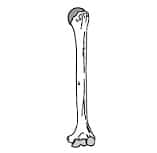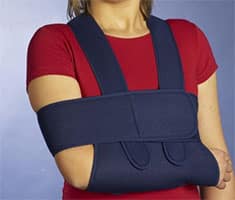 The Latin word humĕrus came into Spanish as humerus . This is the name given to a bone found in the arm , being the largest of the upper extremities.
The Latin word humĕrus came into Spanish as humerus . This is the name given to a bone found in the arm , being the largest of the upper extremities.
At its lower end the humerus connects with the radius and ulna through the elbow joint, while at its upper end it connects with the scapula through the shoulder joint.
It should be remembered that the ends of the long bones are called epiphyses . The proximal epiphysis of the humerus is composed of the head, anatomical neck, surgical neck, greater tubercle, lesser tubercle, and intertubercular groove. In the distal epiphysis , meanwhile, you can recognize the humeral condyle, the trochlea, the capitula, the coronoid fossa, the olecranon fossa, the radial fossa, the lateral epicondyle and the medial epicondyle.
The middle sector of the long bones, on the other hand, is known as the diaphysis . This is the body that develops between the epiphyses. The diaphysis of the humerus presents the body itself with its three faces; the lateral edge; the medial border; and the groove for the radial nerve.
Twenty-five muscles insert into the various sections of the humerus, such as the deltoid , pectoralis major , supinator longus , triceps brachii , and supraspinatus , among others. The bone is also linked to various nerves .
The humerus can be fractured for different reasons, the most common being a person falling to the ground. The vast majority of these fractures do not cause bone displacement, which is why they do not require surgical intervention. Typically, the arm is immobilized for a certain period and painkillers are given to the patient, although the treatment varies according to the characteristics of the injury .
The main objective of the treatments applied to a humerus fracture is to ensure that the patient cannot move the affected area, and to do this, different classic immobilization techniques are used, such as an abduction sling, a device used to support a part of the body that has suffered an injury and prevent it from moving.
 As a complement to immobilization, specialists usually advise their patients to take painkillers, since the pain can be very difficult to bear during the recovery period. Health professionals must recognize the type of humerus fracture before determining the treatment they will choose, since its effectiveness depends on different aspects, such as the potential harmful consequences in certain cases and the risk of deviation of the fragments.
As a complement to immobilization, specialists usually advise their patients to take painkillers, since the pain can be very difficult to bear during the recovery period. Health professionals must recognize the type of humerus fracture before determining the treatment they will choose, since its effectiveness depends on different aspects, such as the potential harmful consequences in certain cases and the risk of deviation of the fragments.
For the most part, humerus fractures that cause slight proximal displacement can be treated without the need for surgery. As mentioned in a previous paragraph, the fundamental procedure of this treatment consists of placing a cast and a sling to immobilize the affected area. In case of anatomical neck fracture, the intervention of an orthopedist is necessary to avoid avascular necrosis .
When the part affected by the fracture is the distal third, treatment may consist of internal fixation of the bone or open reduction. To choose the type of treatment, the patient's opinion and the doctor's preferences are taken into account, since each one has its advantages and disadvantages.
To stabilize a humerus shaft fracture , a coaptation splint must be used, which requires the use of a special cloth to wrap the splint from the nape of the neck to the armpit, passing through the elbow. The compensatory capacity of the elbow allows the angle to range between 30 and 40 degrees.
